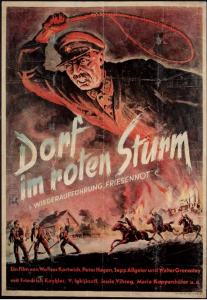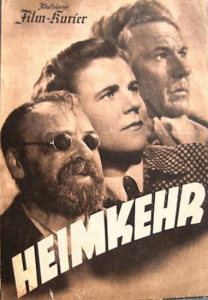
The final event on Friday, March 16, at the “Mennonites and the Holocaust” conference was an evening screening of the 1935 Nazi propaganda film Friesennot, which in English translates to “Frisians in Peril.” Professor of History Mark Jantzen of Bethel College, one of the conference organizers, introduced the film. Jantzen had requested permission to screen the film from the German Federal Film Archive, and he organized English-language subtitles of the German and Russian dialogue. This was the first public screening of Friesennot in the United States since 1936 and its world premiere with English subtitles.
Friesennot was one of several films featuring Mennonite themes promoted by the Third Reich’s Propaganda Ministry. Of these, Friesennot most explicitly depicts Mennonite characters—although even here, the protagonists are referred to not according to their religion but with to the racial term “Frisian.” The film’s plot follows a small Mennonite colony along the Volga in Russia, shortly after the Bolshevik Revolution of 1917. While the Mennonite inhabitants are portrayed as quintessential Germans, the film depicts communists who arrive in their colony as Semitic brutes, who oppress the blond “Aryan” farmers.
The moral dilemma of Friesennot concerns the Mennonites’ pacifism. While the Bolsheviks steal horses and molest women, the Mennonite elder cautions his congregants to turn the other cheek. Continued abuses by the communists prove this foolhardy, however, and eventually the men of the colony take up arms. One evening while the Bolsheviks are inebriated, the Mennonite militia surprises them in the church building—which has been turned into a drinking hall—slaughtering everyone inside. In the final scene, the colonists pack their belongings and depart for a new homeland.

Nazi filmmakers had become interested in Mennonites following an international crisis in 1929 and 1930 when thousands of refugees fled the Soviet Union, arriving both in Germany and in northern China. This event captured German public attention, inspiring extensive newspaper coverage as well as several novels. In 1933, the first film in the Third Reich to win the Propaganda Ministry’s State Film Prize—entitled Flüchtlinge, meaning “Refugees” in English—followed the fate of German-speaking colonists who escaped from the Soviet Union to China.

During the Second World War, Nazi films with Mennonite themes became tied to ethnic cleansing. In 1940, a film called Heimkehr, meaning “Homecoming,” valorized National Socialist programs to resettle hundreds of thousands of German speakers—including Mennonites—from across Europe to occupied Poland, where they were supposed to “Germanize” land previously held by Poles or Jews. With Hitler’s invasion of the Soviet Union in 1941, the Propaganda Ministry also re-released Flüchtlinge and Friesennot—retitled Dorf im roten Sturm, meaning “Village in the Red Storm.”
Following the film screening on Friday, discussants noted the various ways that Friesennot contributed to Nazi programs of anti-Semitism before and during the Second World War. Originally produced in 1935, the film coincided with the re-introduction of German military service as well as the passage of the Nuremberg Laws stripping Jews of citizenship and targeting sexual relations between Germans and Jews—a topic of contention in the film. When re-released during Hitler’s invasion of the Soviet Union, Friesennot helped generate support for the Nazi war effort and stirred up anti-Semitism at the same time that death squads were initiating the Holocaust.

As a student of 20th century European history, I have watched Friesennot, along with most of the films of the Nazis that are available online. Not being able to understand German, I missed the Mennonite connection when I first saw this film. What I could understand didn’t make much sense, even less than most Nazi propaganda. I wonder if the subtitles developed for this showing have been made publicly available.
LikeLike